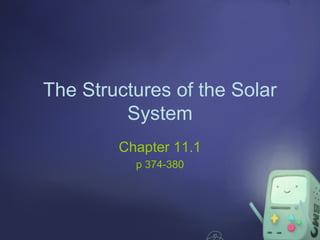
Chapter 11.1: The Structures of the Solar System
- 1. The Structures of the Solar System Chapter 11.1 p 374-380
- 2. What is the solar system? • When looking at the night sky, you will likely see stars and planets. Sometimes, the first starlike object you see at night is not a star at all. • A few of the tiny lights that you can see are part of our solar system. • Almost all of the other specks of light are stars.
- 3. Objects in the Solar System • Ancient observes looking at the night sky saw many stars but only five planets – Mercury, Venus, Mars, Jupiter, and Saturn. – The invention of the telescope in the 1600s led to the discovery of additional planets and many other space objects.
- 4. The Sun • The largest object in the solar system is the Sun, a star. – Its diameter is about 1.4 million km – Its made mostly of hydrogen gas – Its mass makes up about 99 percent of the entire mass of the solar system • Inside the Sun, a process called nuclear fusion produces an enormous amount of energy. – Some of the energy is emitted as light • The Sun also applies gravitational forces to objects in the solar system. – Gravitational forces cause the planets and other objects to move around, or orbit, the Sun.
- 6. Objects That Orbit the Sun • Planets, dwarf planets, asteroids, and comets orbit the Sun. – These don’t emit light.
- 7. Planets • An object is a planet only if it orbits the Sun and has a nearly spherical shape. • The mass of a planet must be much larger than the total mass of all other objects whose orbits are close by. • Our solar system has eight objects classified as planets.
- 8. Inner Planets and Outer Planets • The four planets closet to the Sun are the inner planets. – Mercury, Venus, Earth, and Mars – These planets are mainly made of solid rocky materials
- 9. Inner Planets and Outer Planets • The four planets farthest from the Sun are called the outer planets – Jupiter, Saturn, Uranus, and Neptune – These planets are mainly made of ice and gases such as hydrogen and helium. – Because they are much larger than Earth, we also call them gas giants.
- 10. Dwarf Planets • A dwarf planet is a spherical object that orbits the Sun. – It is not a moon of another planet and is in a region of the solar system where there are many objects orbiting near it. – Unlike a planet, a dwarf planet does not have more mass than objects in nearby orbits – They are made of rock and ice and are much smaller than Earth. – They include Ceres, Eris, Pluto, and MakeMake.
- 13. Asteroids • Millions of small, rocky objects called asteroids orbit the Sun in the asteroid belt between the orbits of Mars and Jupiter – They range in size from less than a meter to several hundred kilometers in length – Unlike planets and dwarf planets, asteroids usually aren’t spherical
- 14. Comets • A comet is made of gas, dust, and ice and moves around the Sun in an oval-shaped orbit. – Comets come from the outer parts of the solar system. – There might be 1 trillion comets orbiting the Sun.
- 16. The Astronomical Unit • On Earth we use meters or kilometer. • Objects in the solar system, are so far apart that astronomers use a larger distance unit. • An astronomical unit (AU) is the average distance from Earth to the Sun – about 150 million km.
- 17. The Motion of the Planets • Revolution and Rotation – The time it takes an object to travel once around the Sun is its period of revolution • Earth’s period of revolution is one year. – The time it takes an object to complete one rotation is its period of rotation • Earth’s period of rotation is one day
- 18. The Motion of the Planets • Planetary Orbits and Speeds – Unlike a ball swinging on the end of a string, planets do not move in circles – Instead, a planet’s orbit is an ellipse – a stretched-out circle – Inside an ellipse are two special points, each called a focus. – These focus points, or foci, determine the shape of the ellipse. – The foci are equal distances from the center of the ellipse.
- 19. The Motion of the Planets • Planetary Orbits and Speeds – A planet’s speed also changes as it orbits the Sun. The closer the planet is to the Sun, the faster it moves. – This also means that planets farther from the Sun have longer periods of revolution. – For example, Jupiter is more than 5 times farther from the Sun than Earth. • It takes Jupiter 12 times longer than Earth to revolve around the Sun.
